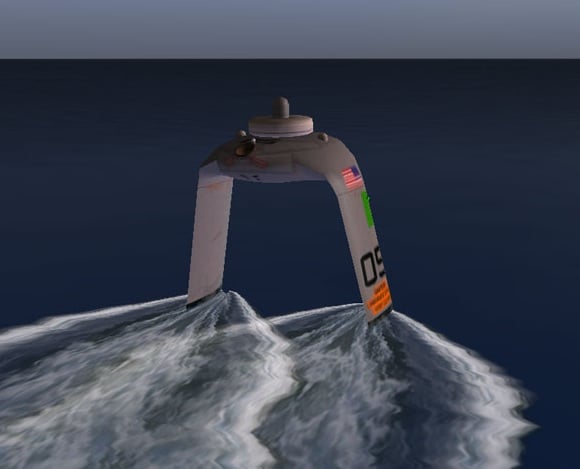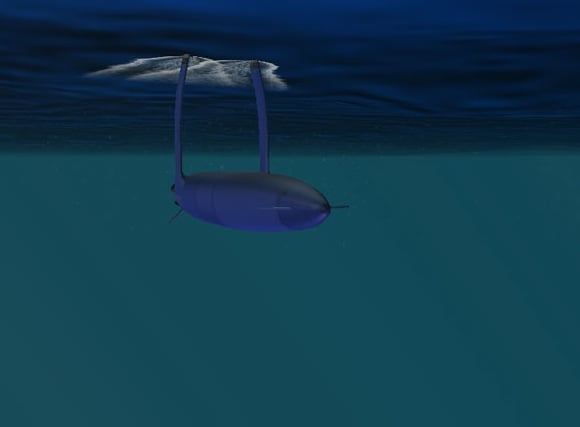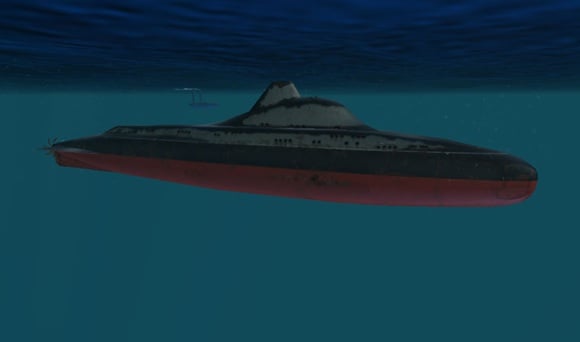Original URL: https://www.theregister.com/2011/04/07/actuv_command_game/
Robo-warship sub hunter: Free DARPA crowdsauce game
Crewless Mary Celeste ghost-frigate sonar thrills
Posted in Science, 7th April 2011 12:55 GMT
No doubt regular readers will recall the US military's cunning plan to develop unmanned submarine-hunting robotic frigates - warships which would prowl the oceans like automated Mary Celestes, remorselessly tracking enemy submarines regardless of how their pale, sweaty, malodorous captains* might twist and turn.

What an unmanned frigate looks like from above...
The Anti-submarine warfare Continuous Trail Unmanned Vessel (ACTUV) project is intended to produce "an X-ship founded on the assumption that no person steps aboard at any point in its operating cycle". The uncrewed frigate would have enough range and endurance for "global, months long deployments with no underway human maintenance", being able to cross oceans and fight its battles largely without any human input - communications back to base would be "intermittent", according to DARPA.
The ACTUV X-ship has taken on a bit more shape since it was first announced. The vessels themselves are envisioned as being designed for seakeeping qualities rather than easy maintenance or the needs of a human crew, and as such would cruise with their main hull submerged below the surface (and probably beneath any troublesome surface layers of the sort which can impede the performance of normal surface-ship hull sonars). The only part of an ACTUV showing above the waves would be an arch-shaped combo engine-intake/funnel unit, which would also act as a mast for communications and above-water sensors such as radar.
The guts of the submerged pod-hull would be much the same as one finds in a normal frigate: diesel and gas-turbine prime movers driving props via an electric transmission, fuel tanks, sonar for searching underwater. None of this requires much innovation.
What does require innovation, however - at least in the perception of those in charge of the project - is the development of a sophisticated set of AI algorithms to handle the ACTUV without any major help from human operators or fleet commanders. One of the contractors to win an ACTUV development deal thus far is sonar-analysis-cum-games-developer-and-audio-studio firm Sonalysts - perhaps most famous for producing submarine-warfare games such as 688 Hunter/Killer and Fleet Command, or possibly for their sound work with such artists as Aerosmith and Debbie Harry.

...and from below.
Perhaps unsurprisingly, then, it has been decided that the best way to hammer out a set of tactics for ACTUVs is to develop a game-style simulation pitting ACTUV against submarine and get people to play it - so crowdsourcing the methods and tactical principles that will then be coded into the robo-frigates' AIs.
The new game - from which these visuals are drawn - is called ACTUV Tactics. The game engine is used in various military sims and in the Dangerous Waters commercial release of 2005. It can be downloaded free in zip format here (323MB). In it, a player tries to find and track an enemy submarine while avoiding collisions with commercial vessels and the like. Various different proposed models of ACTUV robo-frigate are available: Gator, Remora, Seahorse, Shark and Triton. Scores can be uploaded to rankings leaderboards here.
Come on - it's a surface ship. Why does it need to be autonomous?
One should add that ACTUV comes to us courtesy of famous Pentagon crazytech bureau DARPA. This means that the chance of a fleet of Mary Celeste-class crewless subhunters emerging one day from US shipyards is slim at best: about the same as the chance of a legion of autonomous robot land-steamer tanks able to harvest biomass fuel and so potentially end life on Earth like a plague of smoke-belching mechanical locusts.
Comment
The ACTUV plan made a fair bit of sense as originally described - for use against conventionally-powered submarines, to replace manned units in tracking these over long distances. An ACTUV, being unmanned and much faster than a battery-powered craft, could simply sit almost on top of the sub and keep it locked up using powerful active sonar. Not many human captains would want to do this, as it would involving sitting permanently within range of the sub's torpedoes.

Don't know why we're even bothering to use sonar - you can see for miles. Glass-bottomed boat would do the job.
Even so, if a conventional sub commander decided to sink his annoying robotic shadower, he would be unable to get away: battery subs are limited to a crawl if they want to travel any distance submerged, and surfacing or putting up snorkel or 'snort' masts (to run diesels) is suicide as airborne radar can sweep huge stretches of ocean - radar is much better than sonar. Responding manned units starting from the "flaming datum" of the destroyed ACTUV would soon find and destroy the sub as it crept away - all the sooner if it surfaced or put up masts in order to flee more quickly.
So there is no call for much autonomous cleverness by the ACTUV. Following a sub at close range on active is simple enough. Automated dodging of other surface vessels is, again, quite simple under the International Regulations for Prevention of Collisions at Sea, much though ignorant young watchkeeping officers sometimes struggle to grasp the principles. Sure, a wily sub-driver might seek to draw his shadower into a potential collision situation, hoping to force the ACTUV to break off: but the success or failure of this will depend entirely on sonar conditions at the time and the minimum safe passing distance programmed into the ACTUV, not on any cunning tactics.
In any case, an ACTUV chasing a sub could easily be said to be engaged in "underwater operations" and thus claim the status of a vessel "restricted in her ability to manoeuvre" under the Regulations - other ships would be obliged to get out of her way.
All this to one side, there would seem little reason in any event to faff about making the ACTUV highly autonomous. As a surface vessel, there's no difficulty about maintaining a satellite comms link back to a control station where a human operator can run the ship. Existing Predator roboplanes are already handled from the far side of the world in this way, in large numbers. In their case this raises their manning costs noticeably, but this wouldn't apply to ships which would normally require a crew of hundreds.
What makes the ACTUV useful is the fact that it risks no human crew at close range with a potentially hostile sub. A single surface-warfare officer handling it over a sat link doesn't undermine the concept at all: all advanced navies have swarms of surplus officers sitting about on shore anyway, it would be a good idea to put them to work.
So the concept of the new ACTUV game - that it will be used to generate autonomous sub-hunting algorithms - seems rather suspect right off. ®
Bootnote
*Submariners, especially aboard conventionally-powered boats of the sort envisaged as the threat here, generally get very little sun, live at very close quarters (often "hot bunking", ie taking it in turns to sleep in a given bed) and aren't prone to wasting fresh water on personal hygiene or laundry.
Lewis Page was a Royal Navy officer for 11 years.